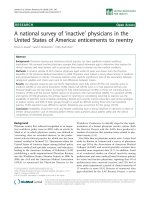Energy Storage in the Emerging Era of Smart Grids Part 10 potx
Bạn đang xem bản rút gọn của tài liệu. Xem và tải ngay bản đầy đủ của tài liệu tại đây (3.52 MB, 30 trang )
3.2 Template directed synthesis
3.2.1 Carbon template 3.2.2 Supramolecular template
3.2.3 Modified anodic aluminum oxide (AAO) template
3.3 Sol-gel process
4. Charge storage mechanism
+−
++→
+− +
++→ +
+
++λ ⇔
-
-
+
++ ⇔
-
↔
+− −+
++↔
++ −
++ ++ ↔5. Electrolytes system for MnO
2
-based supercapacitors
5.1 Aqueous-based electrolytes
5.2 Organic-based electrolytes
5.3 Room temperature ionic liquid electrolytes
5.4 Solid electrolytes
6. The current status and development of MnO
2
-based supercapacitors
8. Acknowledgment
9. References
Nature Materials,
Journal of Materials Research,
New York
Journal of Power
Sources,
Journal of Power Sources
Patent
Journal of The
Electrochemical Society
Chemical Reviews
Chemistry of
Materials
Angew.
Chemie. Int. Ed.
Nano Lett.,
,
Journal of Power Sources
Journal of The Electrochemical Society,
Journal of Power Sources,
Journal of The Electrochemical Society,
Journal of Power Sources,
Journal of Power
Sources
Journal of
The Electrochemical Society
,
J. Mater. Chem.
Science
Journal of the American
Chemical Society
Bull. Chem. Soc. Jpn.
Journal of the American Chemical Society
Journal of
The Electrochemical Society,
Mater. Res. Bull.,
Chemistry of Materials
The Journal of Physical Chemistry C,
Cryst Growth Des,
( ) Journal of
Solid State Chemistry,
( ) Acta
crystallogr
( )
Adv. Mater.
The Journal of Physical Chemistry C,
Nanotechnology,
Chemical Communication
Journal of Power Sources,
The Journal of Physical Chemistry C,
Journal of Solid State Chemistry,
Mater. Chem. Phys.
The Journal
of Physical Chemistry C,
Electrochem. Commun.,
Journal of Power
Sources,
Journal of Power Sources,
Electrochim. Acta,
The Journal of Physical Chemistry B,
Microporous Mesoporous Mater.,
Adv. Funct. Mater
Microporous and
Mesoporous Materials,
Electrochimica Acta,
Langmuir,
Journal of the American Chemical Society,
J Solid State Electrochem
The Journal of Physical Chemistry,
Nanotechnology,
Journal of Nanoscience and Nanotechnology,
,
Journal of Power Sources,
.Journal of
Solid State Chemistry,
Chemical Materials.
Journal of the American Chemical
Society,
Journal of Power Sources
Materials Chemistry and Physics,
Journal of The Electrochemical Society,
The Journal of Physical Chemistry C
Journal of The Electrochemical
Society,
Journal of
The Electrochemical Society,
Surface and
Coatings Technology,
Electrochim. Acta
Journal of Applied Electrochemistry,
The Electrochemical Society Interface • Spring
Electrochim. Acta
Materials Chemistry and Physics,
Solid State Ionics
Materials Letters,
Electrochim.
Acta,
Journal of Power Sources,
Electrochemistry Communications,
Electrochemistry Communications,
Materials Science
and Engineering A,
Journal of Power Sources,
Electrochimica Acta
Chemistry of Materials,
Journal of The Electrochemical
Society,
The Journal of Physical
Chemistry C,
Chemistry of
Materials,
Journal of The Electrochemical Society,
The Journal of Physical Chemistry C,
Applied Materials &
Interfaces,
Chemistry of Materials,
Journal of Power Sources,
Electrochemical and Solid-State Letters
Journal of The Electrochemical Society
,
Energy &
Environmental Science,
Electrochim. Acta,
Electrochim. Acta,
The Electrochemical Society interface,
Electrochimica Acta
Journal of The Electrochemical Society
Journal of The
Electrochemical Society
,
Electrochimica Acta
Journal of Power Sources,
Journal of The Electrochemical
Society,
Journal of Power Sources,
International Journal of Electrochemical Science,
Journal of
Power Sources,
Electrochemistry Communications,
Electrochemical and Solid-State Letters,
European Polymer Journal, ISSN: 0014-3057
Mater. Chem. Phys.,
Journal of Power Sources,
Electrochimica Acta,
Electrochem. Solid-State Lett.,
Journal of the
American Chemical Society,
Electrochimica Acta,
The Journal of Physical Chemistry B,
Microporous
Mesoporous Mater.
Journal of Power Sources,
13
High Temperature PEM Fuel Cells Based on
Nafion
®
/SiO
2
Composite Membrane
XiaoJin Li, ChangChun Ke, ShuGuo Qu,
Jin Li, ZhiGang Shao and BaoLian Yi
Laboratory of Fuel Cell System & Engineering, Dalian Institute of Chemical Physics,
Chinese Academy of Sciences,
China
1. Introduction
1.1 High temperature PEMFC
Polymer electrolyte membrane fuel cell (PEMFC) is considered to be one of the most
promising alternative energy conversion devices for motor vehicles and other stationary
applications, due to its quick start, high energy efficiency, and environmentally friendly
qualities(Marban and Vales-Solis 2007).
At present, most PEMFCs are operated at <80°C, due to the dependence of aboard used per-
fluorinated sulfonic acid membrane (such as Nafion® series) on water. Even so, operating
PEMFC at a high temperature (>100°C) has many benefits (Yang, Costamagna et al. 2001; Li,
He et al. 2003). Firstly, it avoids the existence of two phase flow in the flow field, thus enhances
the stability & reliability of PEMFCs system. Then, operating PEMFC at a high temperature
reduces the power loss caused by the electrochemical polarization of cathode. In addition, high
temperature operation is also beneficial to make use of the exhaust heat of PEMFC system
effectively and enhance the CO endurance of anode(Yang, Costamagna et al. 2001), etc.
The key point of the HT-PEMFC is to develop a type of proton exchange membrane that can
be endurable to the high temperature and still maintain high proton conduction. Because the
most widely used commercial Nafion membrane is not competent for operating at high
temperature due to dehydration. To solve this problem, many kinds of solutions have been
proposed. Generally, these solutions can be divided into three catalogs as followings: a) to
incorporate hydrophilic or proton conductive inorganic nano particles into the Nafion matrix
to prepare so-called inorganic-organic composite membrane(Deng, Moore et al. 1998;
Adjemian, Lee et al. 2002; Adjemian, Srinivasan et al. 2002; Costamagna, Yang et al. 2002; Shao,
Joghee et al. 2004; Xu, Lu et al. 2005; Yonghao Liu, Baolian Yi et al. 2005; Adjemian, Dominey
et al. 2006; Shao, Xu et al. 2006; Alberti, Casciola et al. 2007; Lin, Yen et al. 2007; Casciola,
Capitani et al. 2008; Jian-Hua, Peng-Fei et al. 2008; Jin, Qiao et al. 2008; Jung, Weng et al. 2008;
Rodgers, Shi et al. 2008; Wang, Yi et al. 2008; Yuan, Zhou et al. 2008; Santiago, Isidoro et al.
2009; Yan, Mei et al. 2009); b) to substitute the water in Nafion with non-volatile or low-volatile
polar solvent; c) to prepare new material that can conduct proton independent of water(Deng,
Moore et al. 1998; Adjemian, Lee et al. 2002; Yonghao Liu, Baolian Yi et al. 2005; Lin, Yen et al.
2007; Tang, Wan et al. 2007; Yen, Lee et al. 2007; Rodgers, Shi et al. 2008).
Energy Storage in the Emerging Era of Smart Grids
280
1.2 Nafion inorganic composite membrane
During the above solutions for high-temperature operation of PEMFC, the first solution that
could be also called “Nafion-inorganic composite” (Costamagna, Yang et al. 2002; Mauritz,
Mountz et al. 2004; Shao, Joghee et al. 2004; Adjemian, Dominey et al. 2006; Shao, Xu et al.
2006; Jung, Weng et al. 2008; Wang, McDermid et al. 2008; Wang, Zhao et al. 2008; Yan, Mei et
al. 2009) is most widely investigated at present. Many composite membranes of this type were
reported in literatures, such as Nafion composite membranes with SiO
2
(Mauritz, Stefanithis et
al. 1991; Shao, Joghee et al. 2004; Yonghao Liu, Baolian Yi et al. 2005; Shao, Xu et al. 2006; Tang,
Wan et al. 2007; Yen, Lee et al. 2007; Jin, Qiao et al. 2008; Jung, Weng et al. 2008; Rodgers, Shi et
al. 2008; Wang, McDermid et al. 2008; Yuan, Zhou et al. 2008; Jin, Qiao et al. 2009), sulfonated-
SiO
2
(Wang, Zhao et al. 2008), TiO
2
(Jian-Hua, Peng-Fei et al. 2008; Santiago, Isidoro et al. 2009),
and ZrP (Alberti, Casciola et al. 2007), and etc(Alberti and Casciola 2003; Jones and Rozière
2003). Among these composite membranes, Nafion/SiO
2
composite membrane was most
extensively evaluated and promising, for its relative higher performance and less incidental
problems. Several preparation methods have been reported, such as solution-recast route
(Shao, Joghee et al. 2004), sol-gel method, self-assembling method (Tang, Wan et al. 2007), in-
situ sol-gel method (Adjemian, Lee et al. 2002; Yonghao Liu, Baolian Yi et al. 2005), and so on.
Among these methods, in-situ sol-gel method is a promising process route, because it could
obtain composite membrane with higher uniformity, smaller SiO
2
particles and easy to carry
out. K.A. Mauritz and co-workers (Mauritz, Stefanithis et al. 1991; Mauritz, Stefanithis et al.
1995) first proposed this method, then K.T. Adjemian (Adjemian, Srinivasan et al. 2001;
Adjemian, Lee et al. 2002; Adjemian, Srinivasan et al. 2002) and many other
investigators(Yonghao Liu, Baolian Yi et al. 2005; Yu, Pan et al. 2007) applied Nafion/SiO
2
composite membrane prepared by this or improved method to PEMFC and DMFC.
2. Nafion
®
/SiO
2
composite membrane fabrication
2.1 Membrane fabrication
Nafion/SiO
2
composite membranes were prepared via an in-situ sol-gel reaction of tetraethyl-
orthosilicate (TEOS), as that of Ref (Mauritz, Stefanithis et al. 1991). In our previous work (Ke,
Li et al. 2010; Ke, Li et al. 2011), a technique in controlling silicate nanoparticle diameter in
preparation of Nafion/SiO
2
composite membranes was put forward. The detailed process is
shown as follows. Firstly, the Nafion
(NRE212) membrane (DuPont, USA) was dried in the
vacuum drying oven at 80°C for 12h. Then, the membrane was dipped into the CH
3
OH/H
2
O
solution (30°C) and kept in the CH
3
OH/H
2
O solution for 1 h. After that, the sample was taken
out and the remnant liquid on the surface of the membrane was rubbed out with filter paper.
The sample was then immerged into CH
3
OH/TEOS solution (30°C) to carry out the in-situ sol-
gel reaction for 3 minutes. The diameter of SiO
2
nanoparticle incorporated in Nafion was
controlled by changing the in-situ sol-gel reaction reactant concentrations. After reaction, the
sample was kept in the vacuum drying oven at 80°C for 48 h, and then Nafion/SiO
2
composite
membrane was obtained. In this work, the content of the SiO
2
incorporated into Nafion is
8.5wt.% with a statistical diameter of 10 nm.
Before the subsequent measurements, all the composite membranes were pretreated with
the process as follows. Firstly, membranes were kept in H
2
O
2
(5wt%, 80°C) for 1 h, followed
by rinsing them with de-ionized water (80°C) for two times. Then membranes were soaked
in H
2
SO
4
(0.5M, 80°C) for 1 h. Finally, membranes were rinsed with de-ionized water (80°C)
repeatedly until the PH of the washing water was around 7.
High Temperature PEM Fuel Cells Based on Nafion
®
/SiO
2
Composite Membrane
281
For the ex-situ research of the mechanism of sulfonation, the powder of SiO
2
nano-particles
was also sulfonated by concentrated H
2
SO
4
(98%, 80 °C), just as the sulfonation process of
Nafion/SiO
2
composite membrane. The sulfonation time was 10 h, for the powder SiO
2
.
2.2 Membrane sulfonation
The above obtained Nafion/SiO
2
composite membranes were dried in vacuum drying
chamber for 24 h. Then the samples were soaked in concentrated H
2
SO
4
(98%, 80 °C) for
certain time (4, 10, and 16 h) to sulfonate the composite membrane. The concentrated H
2
SO
4
treated membranes were then soaked in de-ionized water (80 °C) for 12 h, and rinsed with
de-ionized water until the washing water exhibited neutral.
Nafion/SiO
2
sulfonated for 4, 10 and 16 h are signed as Nafion/S-SiO
2
-4h, Nafion/S-SiO
2
-
10h and Nafion/S-SiO
2
-16h, respectively. For the ex-situ research of the mechanism of
sulfonation, the powder of SiO
2
nano-particles was also sulfonated by concentrated H
2
SO
4
(98%, 80 °C), just as the sulfonation process of Nafion/SiO
2
composite membrane. The
sulfonation time was 10 h, for the powder SiO
2
.
3. Spectroscopic studies of Nafion/SiO
2
composite membranes
3.1 FT-IR spectra
Spectroscopic methods are powerful tools for analysis of the chemical structure of the
sample. In order to understand the mechanism of the sulfonation of the Nafion/SiO
2
composite membrane, several spectroscopic methods are used synthetically.
The FT-IR spectra of the membranes were collected from 400 cm
-1
to 1200 cm
-1
, using a
Bruker Vector22 (Bruker Optics, Germany) FT-IR spectrometer at a resolution of 4 cm
−1
in
absorption mode. FT-IR of the powder SiO
2
and sulfonated SiO
2
(S-SiO
2
) nano-particles
were also performed, in order to avoid the background signal of the Nafion matrix. The IR
spectra of the untreated SiO
2
and the sulfonated S-SiO
2
were recorded with potassium
bromide tabletting in transmission mode.
Figure 1 (a) exhibits the FT-IR spectra of the Nafion, Nafion/SiO
2
, Nafion/S-SiO
2
-4h,
Nafion/S-SiO
2
-10h, and Nafion/S-SiO
2
-16h. In fact, as we can see, it is a little difficult to
distinguish the structure change of the Nafion/SiO
2
composite membrane after sulfonation
from Figure 1 (a). This maybe caused by -SO
3
H groups in the side chains of Nafion, which is
much adverse for the identification of the -SO
3
H that maybe attached to the surface of SiO
2
nano particles. Therefore, in this experiment, an ex-situ characterization method was
adopted. Powder SiO
2
nano-particles were prepared outside the Nafion membrane via a sol-
gel reaction of TEOS. Then the obtained SiO
2
was sulfonated (signed as S-SiO
2
) by
concentrated H
2
SO
4
for 10 h at 80 °C as mentioned in section 2.2.
Figure 1 (b) illustrates the spectra of the obtained SiO
2
and sulfonated S-SiO
2
. It is shown
that the peak at 3400 cm
-1
, which is the characteristic signal of -OH, is widened after
sulfonation. It is generally acknowledged that the widening of the hydroxyl peak is caused
by the hydrogen bond. It suggests that there are strong hydrogen bonds in the sulfonated S-
SiO
2
. This should be caused by the interaction between surface -OH groups of SiO
2
nano-
particles and H
2
SO
4
molecules. However, characteristic peaks of the -SO
3
H group are
located in 1000-1100 cm
-1
, which coincides with the strong absorption band of symmetric
and anti-symmetric vibration of the Si-O-Si. For this reason, the structure signal of -SO
3
H is
not clear by FT-IR.









